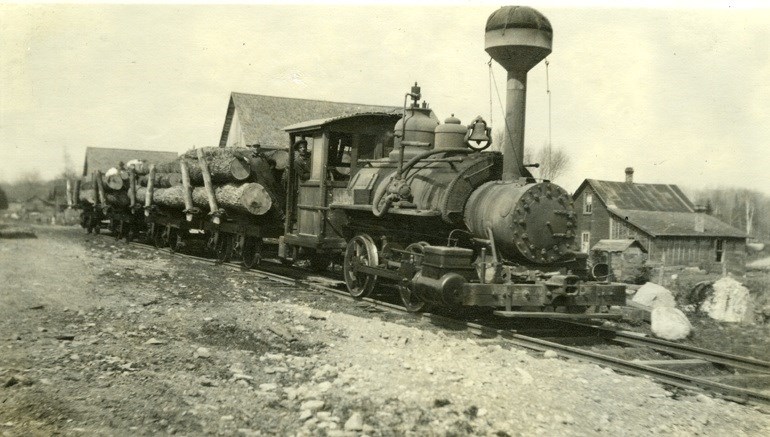From the archives of the Sault Ste. Marie Public Library:
*************************
Remember This . . .The Story of the St. Joseph Island Railway
In the early 1900s a railway was proposed to be built on St. Joseph Island.
In a Sault Star article from 1909, the Sault Board of Trade was informed that a group of capitalists were prepared to build a railway line connecting the existing CPR railway line to Richard’s Landing and linking to the area around Desbarats. The islanders had been asked to contribute to the preliminary expenses and other related costs required to secure a charter. Mr. P.T. Rowland reported that a number of islanders had already subscribed the required $500 to $600 for the work required. The Sault Board of Trade unanimously voted to support the proposed railway.
While this railway, intended to connect the island to the mainland was not built, there was a railway built on St. Joseph Island exclusively for the use of the logging industry.
By 1910, the Stone Lumber Company was formed by W.J. Smith. Mr. S. George Stone, a teacher of ancient history in the Sault, contributed $60,000 towards the formation of this company. However Mr. Stone was an investor only and had no other interest in the company operations. Mr. Smith was the operations manager and controlled the entire company.
For the new lumber company to succeed, they needed to have a railway built in order to transport the logs from the bush to the sawmill in Hilton Beach, a distance of about eight miles.
Construction began immediately on the railway with about $100,000 spent to complete the task. The workers were paid $2 per day for a 10-hour day of laying track.
Unfortunately there were many errors made during the construction process. Maple trees were cut into eight inch by eight inch railway ties, however rather than letting them dry properly, the ties were painted while they were still green. This resulted in the ties rotting and they were forced to rebuild about five miles of track.
Smith received permission to run the railroad across most of the land for no charge. One landowner however wanted $200 and Smith refused to pay him, opting instead to change the course of the railway. This meant that the rail line would now run through a portion of swamp. After numerous unsuccessful attempts to run the track across the swamp, Smith eventually went back to the landowner and paid him the $200 and laid the track across his land instead!
They originally used 30-pound steel for the rails but it proved to be insufficient to carry the load and they had to rip up the track and use 60 pound steel track instead. After all of these roadblocks they were finally ready to run a train on the new railway. Due to the urgency to complete the railway quickly and be able to begin moving logs to the sawmill, they decided not to make any space to allow the engine to turn around. Therefore, the train was forced to back up from Hilton Beach to the logging camp and then load up the five cars with logs and travel forward to the sawmill in Hilton Beach. Naturally this created the opportunity for frequent derailments!
Smith needed an engine for his train so he acquired an engine that had been involved in a head-on collision with another train engine. He had it hauled across the ice from Bruce Mines in pieces and then hired a boiler maker to rebuild it. This engine was known as “Dinky” or by some as the “Betsey”.
The men working in the logging camp were paid about $26 to $30 per month plus room and board while the camp cook was paid $60 per month. The men stayed at the camp during the week and then returned home on weekends even though the logging camp was only about eight miles outside of Hilton Beach.
The railway operated for about 25 years from 1912 to around 1937. Although Smith sold a lot of maple and pine from this property he did not really make any significant money from this venture. When the logging camp ceased to operate during the Depression, the train tracks were torn up and Dinky the engine was sent to the Sault to be scrapped.
*************************
Each week, the Sault Ste. Marie Public Library and its Archives provides SooToday readers with a glimpse of the city’s past.
Find out more of what the Public Library has to offer at www.ssmpl.ca and look for more Remember This? columns here
